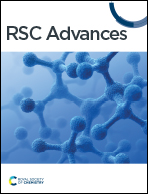Cu and Zn promoted Al-fumarate metal organic frameworks for electrocatalytic CO2 reduction†
Abstract
Metal organic frameworks (MOFs) are attractive materials to generate multifunctional catalysts for the electrocatalytic reduction of CO2 to hydrocarbons. Here we report the synthesis of Cu and Zn modified Al-fumarate (Al-fum) MOFs, in which Zn promotes the selective reduction of CO2 to CO and Cu promotes CO reduction to oxygenates and hydrocarbons in an electrocatalytic cascade. Cu and Zn nanoparticles (NPs) were introduced to the Al-fum MOF by a double solvent method to promote in-pore metal deposition, and the resulting reduced Cu–Zn@Al-fum drop-cast on a hydrophobic gas diffusion electrode for electrochemical study. Cu–Zn@Al-fum is active for CO2 electroreduction, with the Cu and Zn loading influencing the product yields. The highest faradaic efficiency (FE) of 62% is achieved at −1.0 V vs. RHE for the conversion of CO2 into CO, HCOOH, CH4, C2H4 and C2H5OH, with a FE of 28% to CH4, C2H4 and C2H5OH at pH 6.8. Al-fum MOF is a chemically robust matrix to disperse Cu and Zn NPs, improving electrocatalyst lifetime during CO2 reduction by minimizing transition metal aggregation during electrode operation.



 Please wait while we load your content...
Please wait while we load your content...